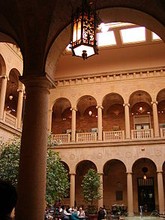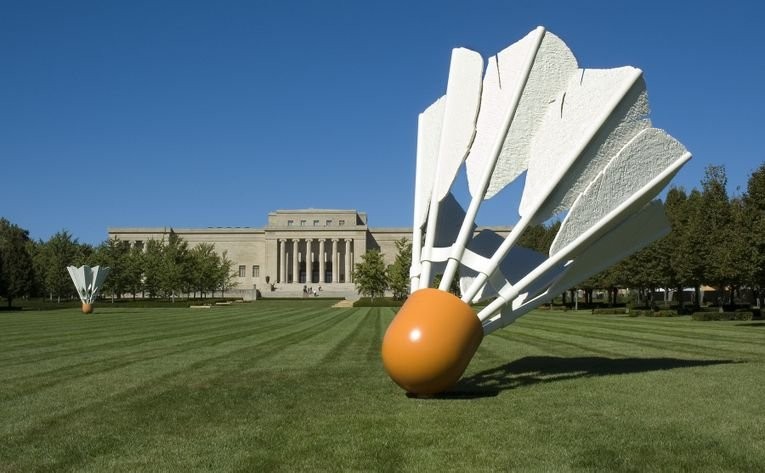Nelson-Atkins Museum of Art
Introduction
Text-to-speech Audio
Founded in 1933, the Nelson-Atkins Museum of Art is one of the country's premier art museums and is well regarded around the world. Its collection is comprehensive, consisting of artworks spanning almost every culture around the globe. It is located in a beautiful Beaux Arts building constructed in 1933 and the modern Bloch Building addition built in 2007. Regions showcased at the museum are: Africa, America, Europe, China, Japan, and South and Southeast Asia. Paintings, sculpture, furniture, ancient artifacts, photographs, decorative arts, works on paper, and everyday objects comprise the collection, which contains 35,000 works of art. The date range of the collection spans from as far back as ancient Greece, Rome, and Egypt, to today. Numerous works by famous artists are included in the collection such as Caravaggio, Titian, Rembrandt, Van Gogh, Monet, Benton, Bosch, and Degas. The museum's logo is derived from the large badminton shuttlecock sculptures created by Claes Oldenburg that are located on the museum grounds.
Images
A panorama view of the Museum in 2008.

More details North façade of the original building (1930-33), with the Bloch Building (1999-2007), left.

The museum Cafe

One of the Claes Oldenburg shuttlecock sculptures that inspired the museum's logo

Backstory and Context
Text-to-speech Audio
The museum is named after two benefactors to the museum, William Rockhill Nelson and Mary Atkins. Both bequeathed funds for the creation of an art museum and it was decided that it would be best to combine the funds of the two philanthropists. The result was the construction of the original 1933 building.
Two brothers led the architectural firm of Wight & Wight that designed the museum: Thomas Wight (1874-1949) and William Wight (1882-1947). Both brothers had been trained at the famous firm of McKim, Mead and White, which had included the great architect Stanford White. Thomas Wight had also been influenced by classical design through his studies in Italy and Greece. The building is in the Beaux-Arts style, named after the Ecole des Beaux-Arts in Paris, a style pioneered in America by McKim, Mead and White. This style involved exteriors whose massive forms were inspired by Greek, Roman and Italian Renaissance architecture. At the time of the original building's construction, Thomas Wight memorably said, “We are building the museum on classic principles because they have been proved by the centuries. A distinctly American principle appropriate for such a building may be developed, but, so far, everything of that kind is experimental. One doesn’t experiment with 2 1/2 million dollars.”
The museum's collection is strong in several areas. It contains the largest body of works by Thomas Hart Benton, who lived in Kansas City, in the country. In recent years, the painting “The Temptation of St. Anthony,” which had been held in storage, and which was previously assumed to have been created by a follower of Hieronymus Bosch or by his workshop, has been authenticated, by The Bosch Research and Conservation Project, as a painting by the famous Netherlandish artist himself. (Less than 50 authenticated works of the artist exist.) The photography collection, donated by Hallmark, includes the history of American photography from 1839 to the present, with “virtually all the major American players and the full range of artistic and technical achievements represented.” Said Peter Galassi, chief curator of photography at the New York's Museum of Modern Art, "The Nelson-Atkins henceforth has a photography collection that, for quality and scope, is among the serious collections in the United States."
The arrival of the Hallmark Photographic Collection at the Nelson-Atkins coincided with the museum's addition of the Bloch Building, a 165,000-square-foot, $200 million gallery and research center. This building, added in 2007 by architect Steven Holl, has been called by a New York Times critic, “the kind of project that cements an architect’s place in the pantheon” and “a near-perfect work” that “reaffirm[s] that art and architecture can happily coexist.” The critic added that, “The result is a building that doesn’t challenge the past so much as suggest an alternate worldview that is in constant shift.” Time Magazine named the Bloch Building number one in its top 10 list of “new and upcoming architectural marvels” in 2007.
William Nelson’s will specified that the art collection would be for public enjoyment, and ever since then, the institution has been committed to serving the community. On Dec. 11, 1933, the William Rockhill Nelson Gallery and Mary Atkins Museum of Fine Arts opened to a “staggering” crowd: nearly 8,000 people toured the building on that day alone. During the Nelson-Atkins dedication ceremony in 1933, Museum Trustee J.C. Nichols said, “There is a welcome here for all. Regardless of the clothes he wears, his wealth or position, may everyone feel that it belongs to him.”
Two brothers led the architectural firm of Wight & Wight that designed the museum: Thomas Wight (1874-1949) and William Wight (1882-1947). Both brothers had been trained at the famous firm of McKim, Mead and White, which had included the great architect Stanford White. Thomas Wight had also been influenced by classical design through his studies in Italy and Greece. The building is in the Beaux-Arts style, named after the Ecole des Beaux-Arts in Paris, a style pioneered in America by McKim, Mead and White. This style involved exteriors whose massive forms were inspired by Greek, Roman and Italian Renaissance architecture. At the time of the original building's construction, Thomas Wight memorably said, “We are building the museum on classic principles because they have been proved by the centuries. A distinctly American principle appropriate for such a building may be developed, but, so far, everything of that kind is experimental. One doesn’t experiment with 2 1/2 million dollars.”
The museum's collection is strong in several areas. It contains the largest body of works by Thomas Hart Benton, who lived in Kansas City, in the country. In recent years, the painting “The Temptation of St. Anthony,” which had been held in storage, and which was previously assumed to have been created by a follower of Hieronymus Bosch or by his workshop, has been authenticated, by The Bosch Research and Conservation Project, as a painting by the famous Netherlandish artist himself. (Less than 50 authenticated works of the artist exist.) The photography collection, donated by Hallmark, includes the history of American photography from 1839 to the present, with “virtually all the major American players and the full range of artistic and technical achievements represented.” Said Peter Galassi, chief curator of photography at the New York's Museum of Modern Art, "The Nelson-Atkins henceforth has a photography collection that, for quality and scope, is among the serious collections in the United States."
The arrival of the Hallmark Photographic Collection at the Nelson-Atkins coincided with the museum's addition of the Bloch Building, a 165,000-square-foot, $200 million gallery and research center. This building, added in 2007 by architect Steven Holl, has been called by a New York Times critic, “the kind of project that cements an architect’s place in the pantheon” and “a near-perfect work” that “reaffirm[s] that art and architecture can happily coexist.” The critic added that, “The result is a building that doesn’t challenge the past so much as suggest an alternate worldview that is in constant shift.” Time Magazine named the Bloch Building number one in its top 10 list of “new and upcoming architectural marvels” in 2007.
William Nelson’s will specified that the art collection would be for public enjoyment, and ever since then, the institution has been committed to serving the community. On Dec. 11, 1933, the William Rockhill Nelson Gallery and Mary Atkins Museum of Fine Arts opened to a “staggering” crowd: nearly 8,000 people toured the building on that day alone. During the Nelson-Atkins dedication ceremony in 1933, Museum Trustee J.C. Nichols said, “There is a welcome here for all. Regardless of the clothes he wears, his wealth or position, may everyone feel that it belongs to him.”
Sources
"About." Nelson-Atkins Museum of Art. Accessed February 12, 2018. https://nelson-atkins.org/about/
"Original Nelson-Atkins Building—Wight and Wight." Nelson-Atkins.org (archived). Access date: 6/2/19. https://web.archive.org/web/20110427180801/http://www.nelson-atkins.org/art/HistBuilding_Wight.cfm.
Russell, Anna. “Kansas City Museum Painting Deemed an Authentic Bosch.” The Wall Street Journal. Publication date: 2/1/16. Access date: 6/2/19. https://blogs.wsj.com/speakeasy/2016/02/01/kansas-city-museum-painting-deemed-an-authentic-bosch/?guid=BL-SEB-93402&dsk=y.
Shattuck, Kathryn. “For a Dear Museum: Love, Hallmark.” The New York Times. Publication date: 2/18/06. Access date: 6/2/19. https://www.nytimes.com/2006/02/18/arts/design/for-a-dear-museum-love-hallmark.html.
Ourousoff, Nicolai. “A Translucent and Radiant Partner With the Past.” The New York Times. Publication date: 6/6/07. Access date: 6/2/19. https://www.nytimes.com/2007/06/06/arts/design/06nels.html.
Lacayo, Richard. "The 10 Best (New and Upcoming) Architectural Marvels." Time Magazine. Publication date: 12/13/07. Access date: 6/2/19. http://content.time.com/time/magazine/article/0,9171,1694467,00.html.
"Serving the Community." Nelson-Atkins.org (archived). Access date: 6/2/19. https://web.archive.org/web/20110519181735/http://www.nelson-atkins.org/art/HistComm.cfm.
"Original Nelson-Atkins Building—Wight and Wight." Nelson-Atkins.org (archived). Access date: 6/2/19. https://web.archive.org/web/20110427180801/http://www.nelson-atkins.org/art/HistBuilding_Wight.cfm.
Russell, Anna. “Kansas City Museum Painting Deemed an Authentic Bosch.” The Wall Street Journal. Publication date: 2/1/16. Access date: 6/2/19. https://blogs.wsj.com/speakeasy/2016/02/01/kansas-city-museum-painting-deemed-an-authentic-bosch/?guid=BL-SEB-93402&dsk=y.
Shattuck, Kathryn. “For a Dear Museum: Love, Hallmark.” The New York Times. Publication date: 2/18/06. Access date: 6/2/19. https://www.nytimes.com/2006/02/18/arts/design/for-a-dear-museum-love-hallmark.html.
Ourousoff, Nicolai. “A Translucent and Radiant Partner With the Past.” The New York Times. Publication date: 6/6/07. Access date: 6/2/19. https://www.nytimes.com/2007/06/06/arts/design/06nels.html.
Lacayo, Richard. "The 10 Best (New and Upcoming) Architectural Marvels." Time Magazine. Publication date: 12/13/07. Access date: 6/2/19. http://content.time.com/time/magazine/article/0,9171,1694467,00.html.
"Serving the Community." Nelson-Atkins.org (archived). Access date: 6/2/19. https://web.archive.org/web/20110519181735/http://www.nelson-atkins.org/art/HistComm.cfm.
